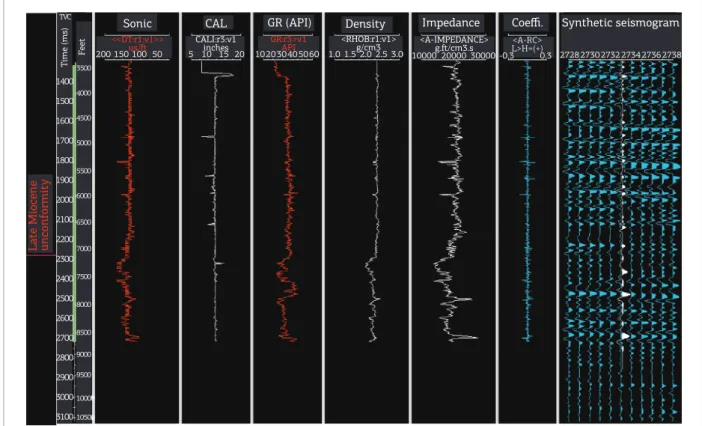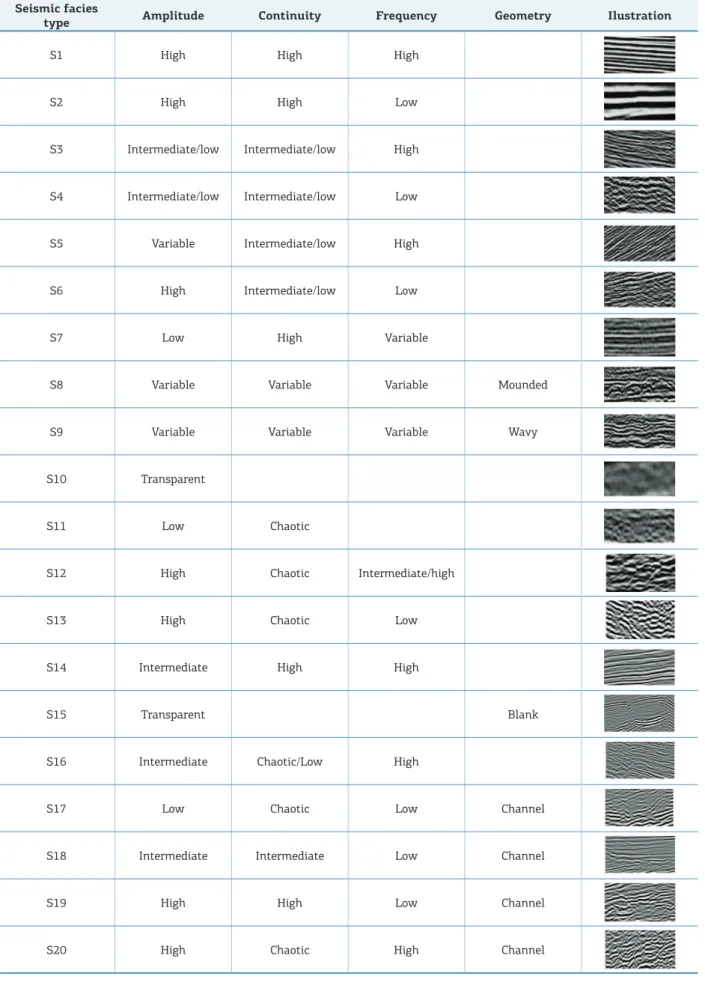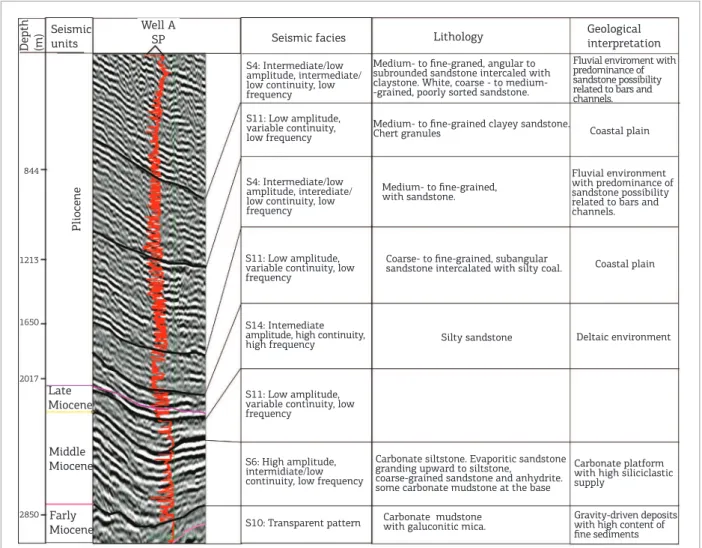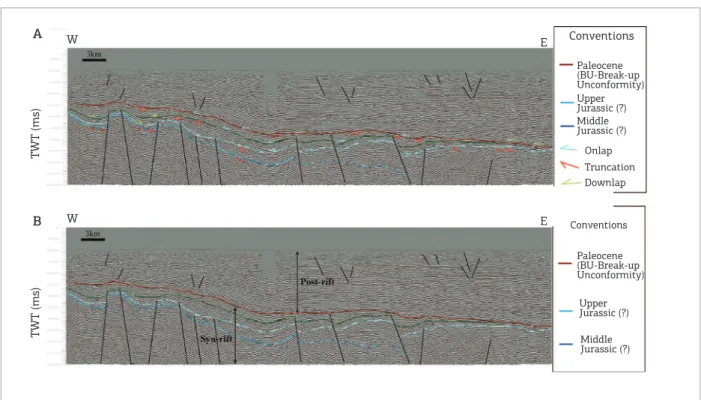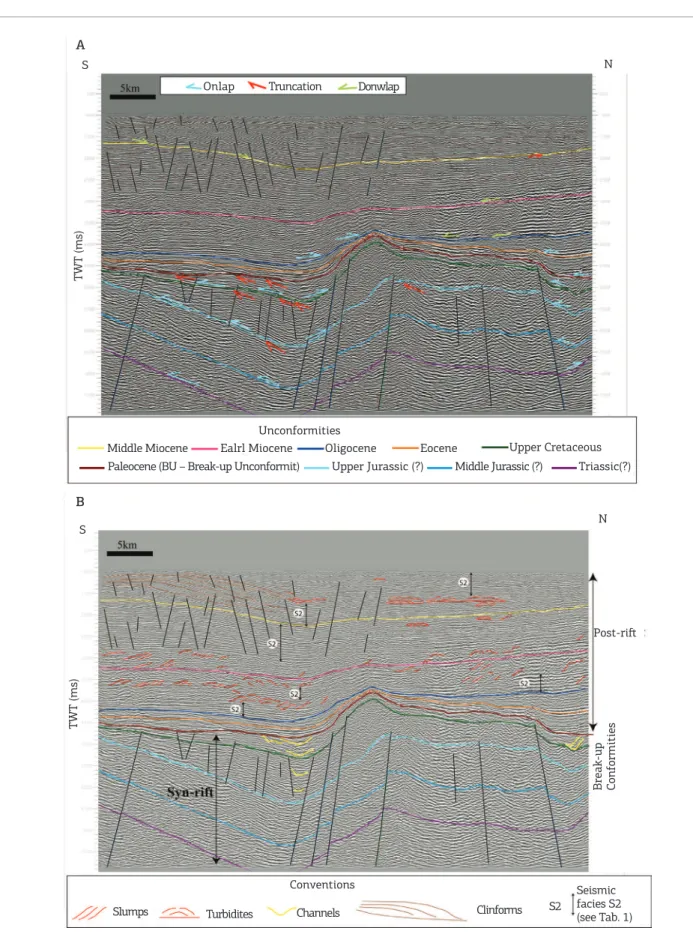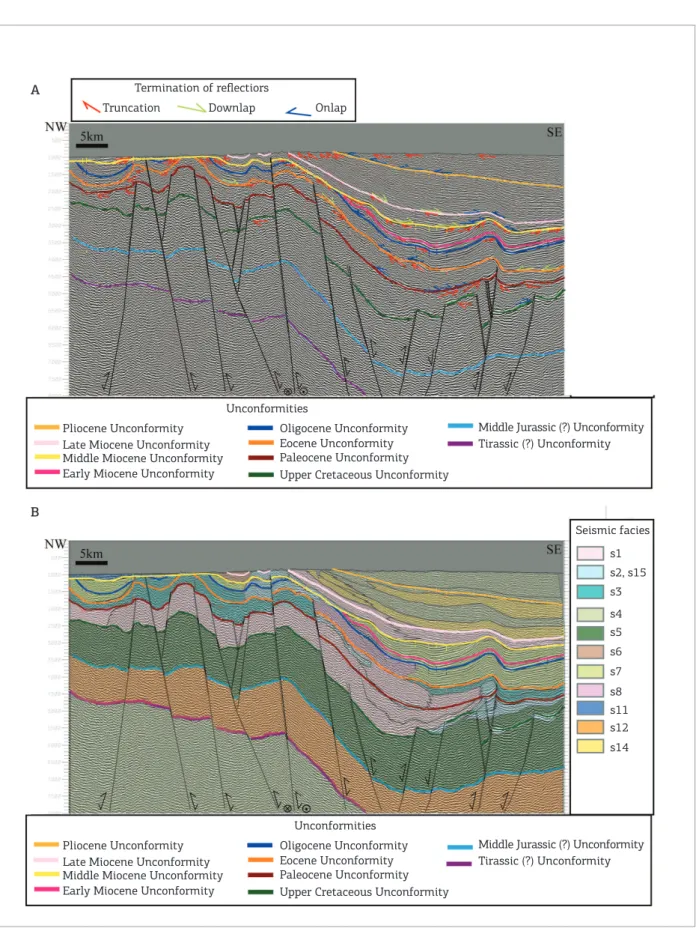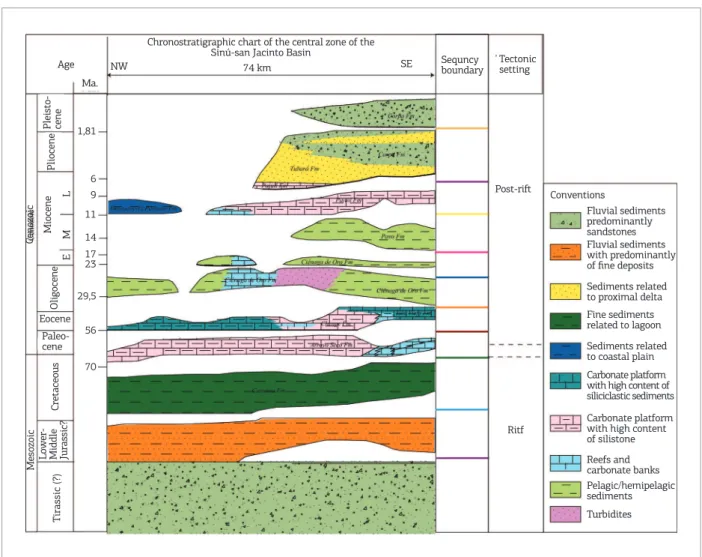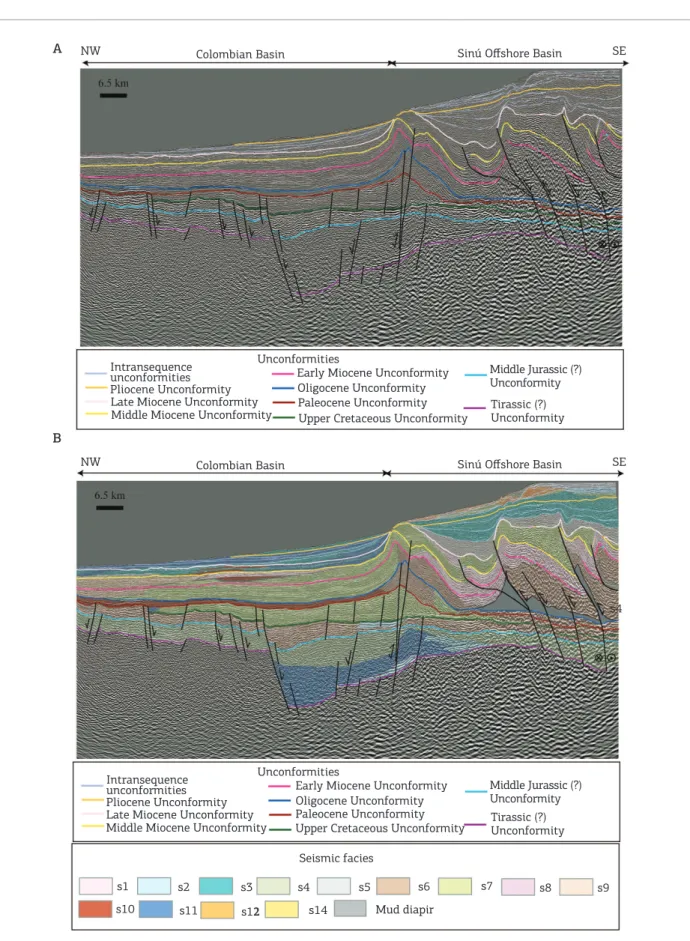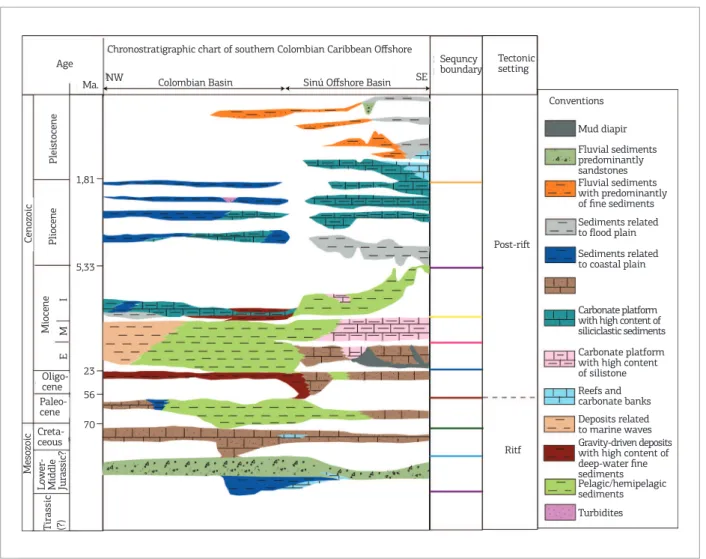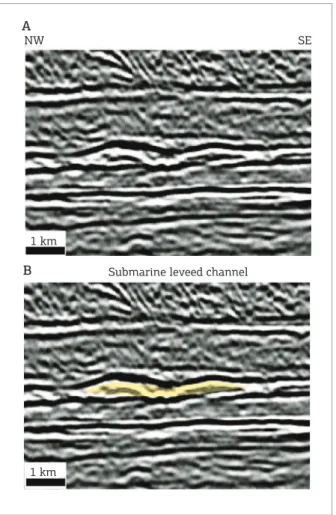1Instituto de Geociências, Programa de Pós-graduação em Geofísica, Universidade Federal da Bahia - UFBA, Salvador (BA), Brazil. E-mail: alfaro.ufba@yahoo.com.br 2Instituto de Geociências, Universidade Federal da Bahia - UFBA, Salvador (BA), Brazil. E-mail: michael@cpgg.ufba.br
*Corresponding author
Manuscrito ID: 30180. Recebido em: 25/07/2014. Aprovado em: 22/10/2014. ABSTRACT: here are diverse controversial and contradictory mo-dels about the geological history of the Caribbean region. Some issues such as the origin of the Caribbean plate, the nature of basement of the Caribbean basins and the regional tectonics, have been in discus-sion during decades. here are disperse and punctual studies across the Caribbean. Application of seismic stratigraphy in regional seismic lines across the Colombian, Sinú Ofshore and Sinú-San Jacinto ba-sins suggests a stratigraphic continuity between these regions. A chro-nostratigraphic chart of the Colombian and Sinú Ofshore basins ba-sed on stratal terminations and seismic facies was propoba-sed. Seven stratigraphic stages were identiied in the Colombian, Sinú Ofshore and Sinú-San Jacinto basins, which, also, have been recognized across the Caribbean region. First stratigraphic stage was characterized by continental to restricted marine deposition during a Triassic/Jurassic rifting. Second, third and fourth stages correspond with deposition of a wide carbonate platform in the Cretaceous, sandy carbonate pla-tform during the Paleocene and carbonate and coarse-grained luvial sedimentation during the Eocene, respectively. Another stage was characterized by rising of base level and deep-water deposition (tur-bidites and pelagic/hemipelagic sediments) during the Oligocene. he Early to Middle Miocene was characterized by shallow marine to luvial sedimentation during falling base level, which was controlled by episodic events of tectonic inversion. During the Late Miocene to recent, the sedimentation consisted of terrigenous coarse-grained deposits. Stratigraphic relationships between these zones, suggest a shared geological history between the Caribbean and northern South America. he geologic continuity founded in this study is easily explained by the model of an in situ origin for the Caribbean plate. KEYWORDS: Caribbean; rifting; sequence; seismic stratigraphy.
RESUMO: Existem diferentes modelos controversiais e contraditorios sobre a história geológica da região do Caribe. A origem da placa Caribe, a natureza do embasamento das bacias do Caribe e o contexto tectônico regional tem sido discutido durante décadas. Existem alguns estudos dis-persos e pontuais na região do Caribe. A estratigraia sísmica aplicada em linhas sísmicas regionais nas bacias Colômbia, Sinú Ofshore e Sinú-San Jacinto sugere uma continuidade estratigráica entre essas bacias. Neste estudo foi proposto uma carta cronoestratigráica das bacias Colômbia e Sinú Ofshore baseada em terminacões estratais e fácies sísmicas. Sete etapas estratigráicas foram identiicadas nas bacias Colômbia, Sinú Ofshore e Sinú-San Jacinto. Essas etapas também foram reconhecidas na região do Caribe. A primeira etapa estratigráica foi caracterizada por deposição continental para marinho restrito durante um evento de rifting no Triássico/Jurássico. As segunda, terceira e quarta etapas foram carac-terizadas pela deposição de extensas plataformas de carbonatos durante o Cretáceo, deposição de uma plataforma carbonática arenosa no Paleoceno e sedimentação carbonática e luvial de grão grosso durante o Eoceno, re-spectivamente. Uma outra etapa foi caracterizada pelo aumento do nível de base e deposição marinha profunda (turbiditos e sedimentos pelági-cos/hemipelágicos) durante o Oligoceno. O Mioceno Inferior e Médio foi caracterizado pela sedimentação marinha rasa para luvial durante uma caída do nível de base controlada por eventos episódicos de inversão tectônica. Durante o Mioceno Superior até o presente a sedimentação foi principalmente terrígena de grão grosso. As relações estratigráicas en-tre as bacias Colômbia, Sinú Ofshore e Sinú-San Jacinto sugerem uma história geológica comum entre o Caribe e o norte de América do Sul. A continuidade geológica proposta neste estudo é facilmente explicada pelo modelo in situ da origem da placa Caribe.
PALAVRAS-CHAVE: Caribe; rifte; sequência; estratigraia sísmica.
Stratigraphic relationships between the
Colombian, Sinú Ofshore and Sinú-San
Jacinto basins based on seismic stratigraphy
Relações estratigráicas entre as bacias Colômbia, Sinú Ofshore e
Sinú-San Jacinto baseadas em estratigraia sísmica
Esteban Alfaro1*, Michael Holz2
INTRODUCTION
Intensive exploratory activities of resources have improved the understanding of continental basins in local scale in North and South America. However, there are diverse and disperse studies along the Caribbean region. he studied area consists of the Sinú-San Jacinto, Sinú Ofshore and Colombian basins in the northwestern region of the Colombian Caribbean (Fig. 1). About the Colombian, Sinú Ofshore and Sinú-San Jacinto basins there are some studies, such as, Duque-Caro (1990); Duque-Duque-Caro et al. (1996); Bowland (1993); Guzmán (2007); Bermudez et al. (2009) and Porras and Ortiz (2009), which reflect on the absence of geologic integration, with local to regional focus. hese studies, also relect interpretations based only on lithostratigraphic fea-tures; and interpretation of data premised on the model of an allochthonous origin for the Caribbean plate.
here are not studies about the relationship between stratigraphic record of the Sinú-San Jacinto, Sinú Ofshore and Colombian basins, neither about the relationship of those records with the geology along the Caribbean region. According with the hypotheses of the model of an in-situ origin for the Caribbean plate, the Caribbean region shows a shared tectono-stratigraphic history from south of North America to north of South America (Klitgord & Shouten 1986; Donnelly 1989; Frisch et al. 1992; Meschede & Frisch 1996; Giunta & Oliveri 2009; James 2005, 2006, 2009, 2012).
he scope of this paper is: (1) to facilitate the correla-tion between the stratigraphic sequences of the northwestern zone of Colombia and the Caribbean region; (2) to demon-strate the stratigraphic continuity between the Colombian, Sinú Ofshore and Sinú-San Jacinto basins; and (3) to pro-pose a chronostratigraphic chart of the Colombian and Sinú Ofshore basins using seismic stratigraphy procedure.
DATA AND METHODOLOGY
Seismic and well data were provided by the Ecopetrol and by the Agencia Nacional de Hidrocarburos of Colombia. Geological and age data were extracted from several well logs descriptions and biostratigraphic zones of some wells (Duque-Caro 2001) and from geological mapping (Gómez et al. 2007).
he seismic and well data were tied using a synthetic seismogram (Fig. 2). his seismogram was constrained from sonic log and checkshot data. he seismic sequences were deined by regional unconformities, using standard seis-mic interpretation procedure (mapping of stratal termina-tions) and seismic facies associations. Based on amplitude,
continuity, frequency and geometry of seismic relectors, a set of seismic facies units was mapped.
he benthic and planktonic zones Ammonia Beccarii (N22-MN23), Uvigerina Subperegrina (N17-N19), Uvigerina Isidroensis (N17-N18), Guttulina Caudriade (N9-N8), Uvigerina Mexicana (N5), Cibicidoides Perlucida (P21-P22), Bulimina Jacksonensis (P10, P12, P17, P18/P19), Rzehakina Epigona (Duque-Caro 2001) were founded in the Pleistocene-recent, Pliocene, Late Miocene, Middle Miocene, Early Miocene, Oligocene, Eocene, Paleocene sequences.
he paleoenvironmental interpretations from seismic facies were correlated with these biozones and descriptions of drill-cores (Fig. 3). he typical deep-water and carbonate seismic facies found in this study have been detailed in several previous seismic facies models (e.g. Sangree & Widmier 1977; Galloway 2001; Posamentier & Kolla 2003; Posamentier & Walker 2006; Weimer & Slatt 2007).
Each seismic relector was interpreted and converted via lattening to a time-space diagram. Seismic facies was merged to this diagram in order to produce the inal chro-nostratigraphic charts. We compiled and reviewed several published studies along the Caribbean region to produce a chronostratigraphic chart which summarizes the stratigraphic record and sequences of the Caribbean region.
RESULTS
Nine seismic sequences from the Jurassic period to the present were recognized in the Sinú Ofshore basin. Twelve seismic sequences from the Triassic period to the present were recognized in the Sinú-San Jacinto basin.
Each sequence was characterized by upper and lower terminations of relectors and seismic facies associations. A total of twenty seismic facies were recognized in this study (Tab. 1). Stratigraphic surfaces and seismic facies were cor-related with several calibration wells; they provided litho-logical and sedimentolitho-logical data (Fig. 3).
Triassic and Jurassic
Sinú-San Jacinto basin
he northern Sinú-San Jacinto basin is the best exam-ple of a Mesozoic rifting. Regionally the syn-rift sequences are thinning toward the eastern and western boundaries of the basin (Fig. 4). Seismic relectors of these sequences are divergent toward the major normal faults, suggesting syn-rift deposition (Figs. 4 to 6).
typical of the Jurassic sequence in the Sinú-San Jacinto basin (Fig. 6).
In the southern and central zone, seismic facies show wide areas of variable amplitude, intermediate to low continuity and high frequency relectors. Reduced areas of variable amplitude,
high continuity and intermediate to low frequency relectors are dispersed. Interpretation of seismic facies suggests ine-grained sediment of wide areas of lood plain systems with inluence of lobate lacustrine areas shattered across lood plains (Figs. 6 and 7). Syn-depositional normal faults continue controlling sedimentation.
Colombian basin Romeral fault system
Sinú Offshore basin
Panamá Arc Sinú-San Jacinto basin
Lower Magdalena Valley basin
Cesar-Rancheira
basin
Santa Marta Massif Oca fault
B/manga-Sta-Marta fault
Uramita fault
Caribbean Sea 13°N
(B) (A)
10°N
7°N
80°W 75°W
South america
Plate
Cocos Plate Magdalena Riv
er
Figure 1. (A) The Caribbean region and the sedimentary basins of the northwestern area of Colombia. Black arrow indicates the relative motion of Caribbean plate respect to the South America plate (according to Egbue & Kellogg 2010). Note the oblique convergence between these plates. Rectangle in bold line shows location of igure in
(B). (B) Location map of seismic lines (bold black lines). Structures compiled from Gómez et al. (2007) and Cediel
et al. (2003), Mantilla-Pimiento (2007); topography/bathymetry from Ryan et al. (2009); centroid-moment-tensor
solutions for earthquakes from Dziewonski et al. (1981); Egbue and Kellogg (2010); Ekström et al. (2012).
A
The Triassic record of the Sinú-San Jacinto basin is characterized by intermediate amplitude, low frequency and intermediate continuity relectors, which are afected by syn-depositional high angle normal faults (Figs. 4 to 6). hese seismic facies suggests the presence of continental sed-imentation associated to grabens and hemigrabens during early stages of a rifting event. Coarse-grained luvial sed-iments, ine-grained sediments related to lood plain and lacustrine systems are associated to this event (Figs. 6 and 7).
Sinú Offshore and Colombian basins
he Sinú Ofshore basin was dominated by shallow marine sedimentation during the Lower Jurassic. Carbonate and ine-grained coastal plain sediments are typical in the Sinú Ofshore area. Carbonate banks and reefs are characterized by high ampli-tude, high continuity and low frequency seismic facies (Fig. 8).
Sediments of coastal plain show low amplitude, chaotic pattern and variable frequency relectors. he Colombian basin was illed by luvial sediments during the Middle Jurassic. hese sediments show intermediate to low ampli-tude, intermediate to low continuity and low frequency seis-mic facies. Deposition of coastal plain and luvial sediments is recorded as growth strata related to high-angle normal faulting during a rifting event (Figs. 8 and 9).
Cretaceous
Sinú-San Jacinto basin
he Cretaceous sequence is characterized by vari-able amplitudes, intermediate to low continuity and high frequency seismic facies, which are shattered across wide areas of intermediate to low amplitude, low to cha-otic and high frequency relectors. Elongate and lobate lagoons placed across a wide coastal plain were deposited during that period.
Sinú Offshore and Colombian basins
In the Sinú Offshore and Colombian basins, sedi-mentation was characterized by high amplitude, interme-diate to low continuity and low frequency seismic facies related to a sandy carbonate platform with some carbon-ate banks and reefs.
Paleocene
Sinú-San Jacinto basin
he Paleocene record is characterized by high ampli-tude, high continuity and high frequency seismic facies. Some zones show high amplitude, high continuity and low
Late Miocene unconf
ormity
<<DT:r1:v1>>
us/ſt CALI:r3:v1inches GR:r3>v1API
T
ime (ms) F
eet <RHOB:r1:v1>g/cm3 <A-IMPEDANCE>g.ſt/cm3.s L>H=(+)<A-RC>
Sonic
200
1400 1500 1600 1700 1800 1900 2000 2100 2200 2300 2400 2500 2600 2700 2800 2900 3000 310010500
10000 9500 9000 8500 8000 7500 7000 6500 6000 5500 5000 4500 4000 3500 TVC
150 100 50 5 10 15 20 102030405060 1.0 1.5 2.0 2.5 3.0 10000 20000 30000 -0.3 0.3 2728 2730 2732 2734 2736 2738
CAL GR (API) Density Impedance Coei. Synthetic seismogram
Figure 2. Well-seismic tie using a synthetic seismogram in the Sinú Ofshore basin.
Table 1. Seismic facies used in this study (Alfaro & Holz 2014). Seismic facies
type Amplitude Continuity Frequency Geometry Ilustration
S1 High High High
S2 High High Low
S3 Intermediate/low Intermediate/low High
S4 Intermediate/low Intermediate/low Low
S5 Variable Intermediate/low High
S6 High Intermediate/low Low
S7 Low High Variable
S8 Variable Variable Variable Mounded
S9 Variable Variable Variable Wavy
S10 Transparent
S11 Low Chaotic
S12 High Chaotic Intermediate/high
S13 High Chaotic Low
S14 Intermediate High High
S15 Transparent Blank
S16 Intermediate Chaotic/Low High
S17 Low Chaotic Low Channel
S18 Intermediate Intermediate Low Channel
S19 High High Low Channel
Depth (m)
Pliocene
Seismic units
844
1213
1650
2017
2850 Late Miocene
Middle Miocene
Farly Miocene
Well A
SP Seismic facies
S4: Intermediate/low amplitude, intermediate/ low continuity, low frequency
S4: Intermediate/low amplitude, interediate/ low continuity, low frequency
S11: Low amplitude, variable continuity, low frequency
S11: Low amplitude, variable continuity, low frequency
S10: Transparent pattern S6: High amplitude, intermidiate/low continuity, low frequency
Carbonate siltstone. Evaporitic sandstone granding upward to siltstone,
coarse-grained sandstone and anhydrite. some carbonate mudstone at the base
Silty sandstone
Coarse- to fine-grained, subangular
sandstone intercalated with silty coal.
Medium- to fine-grained,
with sandstone.
Medium- to fine-grained clayey sandstone.
Chert granules
Medium- to fine-graned, angular to
subrounded sandstone intercaled with claystone. White, coarse - to medium--grained, poorly sorted sandstone.
Fluvial enviroment with predominance of sandstone possibility related to bars and channels.
Coastal plain
Fluvial environment with predominance of sandstone possibility related to bars and channels.
Coastal plain
Deltaic environment
Carbonate platform with high siliciclastic supply
Gravity-driven deposits with high content of
fine sediments
Carbonate mudstone with galuconitic mica. S14: Intemediate
amplitude, high continuity, high frequency S11: Low amplitude, variable continuity, low frequency
Lithology Geologicalinterpretation
Figure 3. Seismic-well tie showing the correlation of the seismic facies and the description of drill-cores in the central Sinú-San Jacinto basin and electric logs (Alfaro & Holz 2014).
frequency relectors. Interpretation of seismic facies indicates the development of a large-scale silty carbonate platform formed in the Sinú-San Jacinto basin.
Sinú Offshore and Colombian basins
In the offshore basins, seismic facies are character-ized by low amplitude, high continuity and variable frequency reflectors. In the northernmost zone, reflec-tors have high amplitude, intermediate to low continu-ity and low frequency. Also, restricted zones with high amplitude, high continuity and low frequency seismic facies do occur.
During Paleocene, the Sinú Ofshore and Colombian basins were controlled by deep-water sedimentation with some carbonate inluence. Several carbonate banks and reefs were formed in the footwall of rift structures. Deep-water settings in these basins were related to late stages of a rifting event. During this period the sedimentation was contemporaneous with activity of normal faults.
Eocene
Sinú-San Jacinto basin
he Eocene sequence represents a wide carbonate plat-form. Three seismic facies related to carbonate settings were interpreted. Wide areas with high amplitude, high continuity and high frequency relectors correspond with a silty carbonate platform. In the eastern and western zones, sedimentation was characterized by a carbonate platform with high siliciclastic input. Some seismic facies with high amplitude, high continuity and low frequency and zones with transparent seismic facies delimited by high amplitude relectors suggest inluence of carbonate banks and reefs.
Oligocene
Sinú-San Jacinto basin
(A) W
TWT (ms)
W
TWT (ms)
(B)
E
E
Conventions
Paleocene (BU-Break-up Unconformity) Upper Jurassic (?) Middle Jurassic (?)
Onlap
Downlap
Conventions Truncation
Paleocene (BU-Break-up Unconformity)
Upper Jurassic (?)
Middle Jurassic (?)
Figure 4. Rit/passive margin system in the northern Sinú-San Jacinto basin (Alfaro & Holz 2014). See location in Fig. 1. (A) Planar normal faults, wedge-shaped syn-rit Mesozoic sequences and divergent relectors related to riting processes. The inal riting is suggested by the break-up unconformity – BU. (B) Interpretation of the syn-rit (Middle Jurassic to Paleocene) and post-rit successions. Seismic line in time (ms).
facies consists of low amplitude, high continuity and vari-able frequency relectors. Oligocene also was characterized by deposition of lobate turbidites, which show mounded seismic facies. he inluence of carbonate banks also is evi-dent in the Oligocene record.
Sinú Offshore and Colombian basins
he Sinú Ofshore and Colombian basins were charac-terized by sedimentation on a slope system. Gravity-driven debris low deposits were controlled by high angle slope and recorded seismic facies characterized by transparent to chaotic relectors. Lateral changes of this seismic facies show hemi-pelagic to hemi-pelagic sedimentation toward the southern zone.
Miocene
Sinú-San Jacinto basin
Stratigraphic record of the Early Miocene in the Sinú-San Jacinto basin is poor. Seismic facies are characterized by low amplitude, high continuity and variable frequency relectors. he Middle Miocene sequence was character-ized by deep-water deposition. Seismic facies correspond to low amplitude, high continuity and variable frequency relectors. Erosional truncations and growth strata, suggest a structural reactivation.
Older normal faults were inverted since Eocene and especially during Middle Miocene. Seismic facies of the Late Miocene sequence are characterized by high amplitude, high continuity and high frequency. Also, low amplitude, cha-otic and variable frequency relectors were identiied in the western zone. his sequence is related with a silty carbon-ate platform and coastal plain settings in the western zone.
Sinú Offshore and Colombian basins
Seismic facies of the Early Miocene are characterized by low amplitude, high continuity and variable frequency relectors. In the northernmost zone, seismic facies with wavy geometry were mapped. hese seismic facies show lat-eral changes to high amplitude, high continuity and high frequency relectors toward the southern zone, suggesting a south to north variation of depositional settings.
Facies are changing from mixed carbonate/siliciclastic platform in the south to deep-water settings characterized by slumps deposits in the northern area. hese slumps are characterized by inclined relectors related to depositional thrusting (Fig. 10).
he Sinú Ofshore and Colombian basins show lateral changes similarly to Early Miocene ones. Mixed carbonate/ siliciclastic seismic facies are located in the southernmost area. Increase in deposition of marine deposits related to
A
(A)
S N
Onlap Truncation Donwlap
S
Unconformities
Conventions Middle Miocene
Paleocene (BU – Break-up Unconformit) Upper Jurassic (?) Middle Jurassic (?)
Slumps Turbidites Channels Clinforms S2
Seismic facies S2 (see Tab. 1)
Triassic(?)
Ealrl Miocene Oligocene Eocene Upper Cretaceous
N
Post-riſt
Break
-up
Conf
ormities
TWT (ms)
TWT (ms)
(B)
Figure 5. System of horst and hemi-graben in the northern Sinú-San Jacinto basin (Alfaro & Holz 2014). See location in Fig. 1. (A) Termination of relections in the boundaries of the sequences. Observe the erosive truncations at the top of the Paleocene sequences (break-up unconformity – BU). (B) The syn-rit sequences with the wedge-shaped geometry and divergent relectors typical of rit processes. Seismic line in time (ms).
A
(A) Termination of reflectiors
Truncation Downlap
Unconformities Pliocene Unconformity
Tirassic (?) Unconformity
Seismic facies s1
s4 s5 s6 s7 s8 s11 s12 s14 s3 s2, s15 Middle Jurassic (?) Unconformity Oligocene Unconformity
Eocene Unconformity Paleocene Unconformity Upper Cretaceous Unconformity Early Miocene Unconformity
Middle Miocene Unconformity Late Miocene Unconformity
Unconformities Pliocene Unconformity
Tirassic (?) Unconformity Middle Jurassic (?) Unconformity Oligocene Unconformity
Eocene Unconformity Paleocene Unconformity Upper Cretaceous Unconformity Early Miocene Unconformity
Middle Miocene Unconformity Late Miocene Unconformity
Onlap
(B)
Figure 6. Seismic line in time (ms) in the central Sinú-San Jacinto basin (Alfaro & Holz 2014). (A) Interpretation of seismic sequences delimited by termination of relectors in the central Sinú-San Jacinto basin. Note that these sequences are afected by a lower structure. Note the solution of focal mechanism in Fig. 1 suggests the dextral sense of strike-slip structure in this seismic line. (B) Interpretation of seismic facies. Description of each seismic facies unit is shown in Tab. 1. See location in Fig. 1.
waves, debrites, submarine leveed channels and turbidites occurred in the Colombian basin (Fig. 11).
he Late Miocene sequence is seismically characterized by low amplitude, high continuity and variable frequency in the Sinú Offshore basin. In the Colombian basin, a sequence characterized by intermediate to low amplitude, intermediate to low continuity and high frequency relectors was deposited. his basin also shows some zones of trans-parent seismic facies. During Late Miocene, the southern Sinú Ofshore was dominated by a coastal plain, which was afected by a syn-depositional lower structure (Fig. 8). Our proposal is that the oblique convergence between the Caribbean and South American plates (Fig. 1) suggests a transpressive regime, which has been controlled the falling base level and consequently the generation of incised chan-nels in the Sinú Ofshore basin (Fig. 12). he Colombian basin was afected by deposition on a mixed carbonate/ siliciclastic platform with inluence of some gravity-driven deposits controlled by a high angle slope.
Pliocene and Pleistocene-recent
Sinú-San Jacinto basin
he Pliocene sequence in the Sinú-San Jacinto basin is char-acterized by intermediate amplitude, high continuity and high frequency relectors. Also, this sequence shows intermediate to low interbedded amplitude, intermediate amplitude and low fre-quency relectors. his seismic signature indicates that the Sinú-San Jacinto area was dominated by highly siliciclastic sedimentation. Deposition on a proximal deltaic setting was afected by episodic deposition of coarse-grained luvial sediments. he Pleistocene to present is characterized by intermediate to low amplitude, intermediate to low continuity and low frequency seismic facies. his basin was dominated by luvial sedimen-tation during Pleistocene to present.
Sinú Offshore and Colombian basins
he Pliocene sequence in the Sinú Ofshore basin is characterized by variable amplitude, intermediate to low
T
irassic (?)
Lo
w
er-Middle Jurassic?
Cretaceous
Paleo-cene Eocene
Oligocene
Cenozoic Miocene
E
M
L
Pliocene
Pleisto- cene Age
Ma.
Chronostratigraphic chart of the central zone of the Sinú-san Jacinto Basin
NW 74 km SE Sequncy
boundary
Tectonic setting
Post-riſt
Conventions
Turbidites Ritf
Pelagic/hemipelagic sediments Reefs and carbonate banks Carbonate platform with high content of silistone Carbonate platform with high content of siliciclastic sediments Sediments related to coastal plain Fine sediments related to lagoon Sediments related to proximal delta Fluvial sediments with predominantly
of fine deposits
Fluvial sediments predominantly sandstones 1,81
6 9
11
14
17 23
29,5
56
70
Mesozoic
(A)
Unconformities
Colombian Basin Sinú Offshore Basin SE
NW
Colombian Basin Sinú Offshore Basin SE
NW
Pliocene Unconformity
Tirassic (?) Unconformity
Seismic facies
s1
s4
s5
s4 s6 s7 s8 s9
s11
s10 s12 s14 Mud diapir
s3 s2
Middle Jurassic (?) Unconformity Oligocene Unconformity
Intransequence unconformities
Paleocene Unconformity Upper Cretaceous Unconformity Early Miocene Unconformity
Middle Miocene Unconformity Late Miocene Unconformity
Unconformities
Pliocene Unconformity
Tirassic (?) Unconformity Middle Jurassic (?) Unconformity Oligocene Unconformity
Intransequence unconformities
Paleocene Unconformity Upper Cretaceous Unconformity Early Miocene Unconformity
Middle Miocene Unconformity Late Miocene Unconformity (B)
Figure 8. (A) Interpretation of nine seismic sequences in a seismic line across the Sinú Ofshore and Colombian basins in the ofshore Colombian Caribbean. Seismic line in time (ms). Note that the high-angle normal faults and lower structures observed in the onshore zone are also recognized in the ofshore area. Observe that the solution of focal mechanism in Fig. 1 suggests the dextral sense of strike-slip structure in this seismic line. (B) Interpretation of seismic facies in the Sinú Ofshore and Colombian basins in the ofshore Colombian Caribbean. Description of
T
irassic
(?)
Lo
w
er-Middle Jurassic? Creta-ceous Paleo-cene
E
M
I
Oligo-cene
Cenozoic
Miocene
Pliocene
Pleistocene
Age
Ma.
Chronostratigraphic chart of southern Colombian Caribbean Offshore
NW Colombian Basin Sinú Offshore Basin SE
Sequncy boundary
Tectonic setting
Post-riſt
Conventions
Turbidites Ritf
Pelagic/hemipelagic sediments Reefs and carbonate banks Carbonate platform with high content of silistone Carbonate platform with high content of siliciclastic sediments Sediments related to coastal plain
Deposits related to marine waves Gravity-driven deposits with high content of
deep-water fine
sediments Sediments related
to flood plain
Fluvial sediments with predominantly
of fine sediments
Fluvial sediments predominantly sandstones Mud diapir
1,81
5,33
23
56
70
Mesozoic
Figure 9. Chronostratigraphic chart across the Sinú Ofshore and Colombian basins built from seismic line in previous igure. Observe that the riting event was characterized by continental to shallow marine sedimentation. The Oligocene to Early Miocene was dominated by deep-water deposition during rising of base level, whereas, the Middle Miocene to recent was characterized by shallow marine to luvial depositions.
continuity and high frequency seismic facies. his basin was dominated by mixed carbonate/siliciclastic sedimen-tation. Carbonate banks and reefs, also, were deposited in this basin. During Lower Pliocene, ine-grained sediments related to lood plain were deposited.
In the Colombian basin, the Pliocene sequence shows low amplitude, chaotic and variable frequency seismic facies. Reduced areas are characterized by variable amplitude, inter-mediate to low continuity and high frequency seismic facies. his suggests that sedimentation on a coastal plain with little inluence of a mixed carbonate/siliciclastic platform domi-nated the Colombian basin during Pliocene.
he Sinú Ofshore basin is characterized by high ampli-tude, chaotic and variable to intermediate to high seismic facies. Also, this basin show intermediate to low amplitude, intermediate to low continuity and low frequency relectors. he Sinú Ofshore basin was dominated by ine-grained luvial
channels and lood plain sedimentation during Pleistocene; however, there is inluence of canyons related to high-angle slope during late stages of Pleistocene to the present. he Pleistocene to recent in the Colombian basin is character-ized by high amplitude, chaotic and intermediate to high seismic facies. his basin was mostly characterized by devel-opment of luvial channels.
DISCUSSION
(A)
NW SE
(B) Slumps
1 km
1 km
Figure 10. (A) Seismic line uninterpreted in the Colombian Basin. (B) Slumps deposits deposited during Early Miocene, across a high angle slope in the Colombian basin. Observe the depositional thrusts, which are suggesting a low direction toward northwestern.
(A)
NW SE
(B) Submarine leveed channel
1 km
1 km
Figure 11. (A) Seismic line uninterpreted in the Colombian basin. (B) Submarine leveed channels deposited during Middle Miocene in the Colombian basin. Seismic line in time (ms).
by the formation of red beds and evaporites in the Gulf of Mexico; volcanism in Cuba; red beds, carbonates, vol-canic sills and lows in the Guajira Peninsula and Mérida Andes; volcanic and red tufs in the Santa Marta Massif; thick sequences of marine sediments in North Range of Trinidad; sediments of neritic settings in the western area of Cuba; thick successions of dolomite in north of Cuba; red beds in the Perijá Sierra and Eastern Cordillera in northern Colombia and Venezuela; thick red beds with a northeast direction in the Maya and Chortis blocks in Central America and grabens and horst with a northeast-ern direction (MacDonald 1964; Lockwood 1965, 1971; Rollins 1965; Álvarez 1968; Stainforth 1969; Bellizia 1972; Kugler 1972; Irving 1975; Pardo 1975; Walper 1981; Feo-Codecido et al. 1984; Maze 1984; Crawford et al. 1985; González & Lander 1990; McCollough & Carver 1992; James 2009) (location in Fig. 1).
A wide carbonate platform was deposited during Eocene in the Sinú-San Jacinto basin (Alfaro & Holz 2014).
his depositional event is equivalent to sedimentation of chert interbedded with chalk and carbonate in the Beata Ridge and the Venezuela basin in the Caribbean ofshore (James 2009) (location in Fig. 1). his chert event has been also documented in the Florida Peninsula; Lesser Antilles and has been related to the seismic horizon A´´ in the Caribbean ofshore (Mattson et al. 1972; Edgar et al. 1973; Schlager et al. 1984; Roberts et al. 2005).
he Sinú Ofshore and Colombian basins in this study, meanwhile, doesn’t show evidence of Eocene record, which suggest a major erosive or non deposition event in these basins. his event is also suggested by low-sorting and thick lysch deposits in the Caribbean (Stainforth 1969; James 1997, 2005, 2006).
Flysch sediments and an erosive hiatus is documented in the Central America in the Rivas, Las Palmas and Brito formations; between the Maya and Chortis blocks; in the Guaniguanico Cordillera in Cuba; in the Richmond Formation in Jamaica; in the German Formation in
A A
(A)
NW SE
(B)
Incised channel 1 km
1 km
Figure 12. (A) Seismic line uninterpreted in the Sinú Ofshore basin. (B) Incised channels seismically characterized by high amplitude, discontinuous relectors and “V” geometry. Seismic line in time (ms).
Puerto Rico; in the Point-a-Pierre, Chaudiere and Lizard Spring Formations in Trinidad; in the Rincón Formation in Venezuela ofshore; in the Scotland Group in Barbados; in the boundary of the Hess Escarpment and the Colombian Basin; in the Ocozocuautla Formation in southeastern Mexico; in the Parras and Chicontepec basins in north-eastern Mexico, in the Veracruz Basin in north-eastern Mexico and in the Middle Valley of Magdalena Basin in Colombia (Dengo 1968; Mattson et al. 1972; Mossman & Viniegra 1976; Tardy et al. 1994; Mora et al. 1996; James 2009; Alfaro et al. 2013) (Fig. 1).
According to this study, lateral and vertical changes of seismic facies in the Sinú-San Jacinto, Sinú Ofshore and Colombian basins, suggest a major falling base level event, during which shallow marine sediments shifted to continental sedimentation in the Miocene to recent. his event was characterized by a major pulse in the Middle Miocene, which, is recorded seismically in this study, as a regional erosive unconformity. his unconformity has been also recognized in Panamá, Dominican Republic and interior of the Caribbean plate (Biju-Duval et al. 1982; Okaya & Ben-Avraham 1987; Duque-Caro 1990; Maufret & Leroy 1997; Jacques & Otto 2003; García-Senz
& Pérez-Estaun 2008).his erosive event has been associ-ated to the collision of the Panama Arc with southwestern Caribbean during Middle Miocene (James 2009; Duque-Caro 1990) (Fig. 1).
In the Interior Sierra in eastern Venezuela, occurred an important structural event during Middle Miocene. Erosive truncations of Miocene were observed in the southern bound-ary of Hess Escarpment (Alfaro et al. 2013).
According to the observations in this study, the Sinú-San Jacinto, Sinú Ofshore and Colombian basins in north-west Colombia, show a shared geologic history. he seismic sequences of Triassic to recent in the Sinú-San Jacinto cor-relate with the sequences that have been interpreted in this study, in the Sinú Ofshore and Colombian basins. hese basins suggest events of shallow marine to continental sed-imentation during a Mesozoic rifting.
he sequences deposited in the Oligocene and Early Miocene were characterized by deep-water sedimentation during an event of rising base level. he sequences of Middle Miocene to recent suggest major events of falling base level, which were characterized by shallow marine to continen-tal settings. hese observations suggest a stratigraphic and tectonic continuity between the Colombian, Sinú Ofshore and Sinú San Jacinto basins.
Compilation from previous studies shows that the same sequences and events also can be traced along the Caribbean region (Fig. 13). herefore, we suggest that the geologic fea-tures (tectonic and stratigraphic) founded in these basins have continuity along the Caribbean region. In fact, these observations are not adequately explained by the allochtho-nous origin of the Caribbean plate, due to the fact that the allochthonous model implies significant differences in the geological history of the Caribbean region, northern South America and southern North America.
According to the allochthonous model, the Caribbean plate was formed during Upper Cretaceous near to the present-day, in the Galapagos hotspot in the Paciic Sea (Burke 1988; Pindell et al. 1988; Kerr & Tarney 2005; Pindell & Kennan 2009). On the other hand, the geologic continuity observed in this study, is easily explained by the model of an in-situ origin for the Caribbean plate, which proposes a conservation of stratigraphic trends along the Caribbean region, northern South America and south-ern North America. According with in-situ model, the Caribbean plate, was formed by the separation between North and South American plates during a Triassic to Jurassic intracontinental rifting (Ball et al. 1969; Stainforth 1969; Skvor 1969; Aubouin et al. 1982; Sykes et al. 1982; Klitgord & Shouten 1986; Donnelly 1989; Frisch et al. 1992; Meschede & Frisch 1996; Giunta & Oliveri 2009; James 2005, 2006, 2009, 2012).
A
Figure 13. Generalized cronostratigraphic chart along the Caribbean region, from southern North America to northern South America and its correlation with sequences identiied in the Sinú-San Jacinto, Sinú Ofshore and Colombian basins. Observe a shared geologic history with the stratigraphic evolution of the Sinú-San Jacinto, Sinú Ofshore and Colombian basins summarized in Figs. 7 and 9. Generalized cronostratigraphic chart proposed in this study along the Caribbean region, from southern North America to northern South America with information compiled from MacDonald (1964); Rollins (1965); Lockwood (1965, 1971); Álvarez (1968); Forero (1967); Burgl (1967); Radelli (1967); Dengo (1968, 1975, 1985); MacDonald and Hurley (1969); Skvor (1969); Stainforth (1969); Tschanz et al. (1969); Edgar et al. (1971); Hall et al. (1972); Kugler (1972); Mattson et al. (1972); Meyerhof and Meyerhof (1972); Wehrmann (1972); Kaufman (1973); Saunders et al. (1973); Bowin (1975); Irving (1975); Ludwing et al.
(1975); Pardo (1975); Horne et al. (1976); Mossman and Viniegra (1976); Ortega-Gutiérrez (1978); Dickey (1980);
Barker and McFarlane (1980); Rémane (1980); Abouin et al. (1982); Biju-Duval et al. (1982); Walper (1981); Bouysse
(1984); Feo-Codecido et al. (1984); Mattson (1984); Maze (1984); Schlager et al. (1984); Crawford et al. (1985); Pereira
(1985); Wadge and MacDonald (1985); Bourgois et al. (1987); Okaya and Ben-Avraham (1987); Sharp and Snoke
(1988); Donnelly (1989); Frost and Snoke (1989); González and Lander (1990); Holcombe et al. (1990); McCollough
and Carver (1992); Restrepo-Pace (1992); Bowland (1993); Tardy et al. (1994); Driscoll et al. (1995); James (1997,
2005, 2006); Maufret and Leroy (1997); Muñoz et al. (1997); Ysaccis (1997); Lewis (2002); Jacques and Otto (2003);
Wright (2004); Roberts et al. (2005); Nance et al. (2006); Rogers and Mann (2007); García-Senz and Pérez-Estaun
(2008); Cooney and Lorente (2009) and Trainor et al. (2011). Seven stratigraphic stages were identiied in the
Unconformities Deposital system Tectonics Correlation with unconformitics of Sinú-San Jacinto,
Sinú Offshore and
Colombin basins Limestones, basaltes-dolerites (B”horizon) Metagranites, gneisses, anfibolites, granulites, charnocritic gneisses, granites, granitic gneisses Precambrian Paleozoic Continental Grenville Orogeny Collision, accretion Continental to shallow marine Continental riſt and volcanism Phyllite, granites periodites, pegmatites, meta-arkosic sandstones granitic orthogneiss, schists
Red beds, evaporites, basic dikes, red-lithic tuffs Red beds, dolomites,
evaporites, volcanic breccias, andesitic-riolitic tuffs Limestones, volcanic lenses, shale Limestones, volcanogenic sandstones Silststones, limestone, chert, chalk, volcanogenic sandstones Quartzites, sandstones, chert and limestone (A”horizon), tuffs, turbidites, radiolaria Passive margin Deep-water Albian Jurassic Middle jurassic Santonian Campanian Shallow marine Shallow marine Paleocene Paleocene Upper Cretaceous Middle Eocene Eocene Oligocene Oligocene Middle Miocene Middle Miocene Continental to shallow marine Deep-water Shallow marine to deep-water Continental Collision, accretion, strike-slip Carbonate and volcanic turbidites, volcanice siltstones Volcanic turbidites, terrigenous siltstones Conglomerates, sandstones, terrigenous siltstones Lithology SE South America NW Gulf of México
Jurassic Pre- cambrian Paleozoic Cretaceous P aleocene Eocene Oligocene Miocene- recent
CONCLUSIONS
According with this study, we can conclude that:
1. Seven stratigraphic stages were identiied in the Colombian, Sinú Ofshore and Sinú-San Jacinto basins, which, also can be traced across the Caribbean region. his fact sug-gests a tectonic and stratigraphic continuity between these zones.
2. First stratigraphic stage was characterized by continen-tal to restricted marine deposition during a Triassic/ Jurassic rifting. Second, third and fourth stages corre-spond with deposition of a wide carbonate platform in the Cretaceous, sandy carbonate platform during the Paleocene and carbonate and coarse-grained luvial sedi-mentation during the Eocene, respectively. Another stage was characterized by rising of base level and deep-water deposition during the Oligocene. he Early to Middle
Miocene was characterized by shallow marine to luvial sedimentation during falling base level, which was con-trolled by episodic events of tectonic inversion. During the Late Miocene to recent, the sedimentation consisted of terrigenous coarse-grained deposits.
3. his geologic continuity is easily explained by the model of an in situ origin for the Caribbean plate.
ACKNOWLEDGEMENTS
he authors acknowledge the Agencia Nacional de Hidrocarburos of Colombia and Ecopetrol for supply-ing the data which made the present study possible. he authors also acknowledge the Centro de Pesquisa em Geoisica e Geologia (CPGG) from the Universidade Federal da Bahia.
Alfaro E. Barrera D.F., Rossello E.A. 2013. Diachronic Cenozoic wrenching in southwest of Colombian basin. Comunicações Geológicas, 100(1):55-65.
Alfaro E. & Holz M. 2014. Review of the chronostratigraphic charts in the Sinú-San Jacinto Basin based on new seismic stratigraphic interpretations. Journal of South American Earth Sciences,
56:139-169.
Álvarez W. 1968. Geology of the Simarua and Carpintero areas, Guajira Peninsula, Colombia. Ph.D. Thesis. Princeton University,
Princeton, 168 p.
Aubouin J., Baltuck M., Arnott R. J., Bourgois J., Filewiez M., Helm R., Kvenvolden K.A., Lienert B., McDonald T., McDougall K., Ogawa Y., Taylor E., Winsborough B. 1982. Leg 84 of the Deep Sea Drilling Project, subduction with accretion, Middle America Trench of Guatemala. Nature, 297:458-460.
Ball M.M., Harrison C.G.A., Supko P.R. 1969. Atlantic opening and the origin of the Caribbean. Nature, 223:167-168.
Barker L. McFarlane N. 1980. Notes on some sedimentological evidence for shallow water origin of parts of the Scotland Formation of Barbados. Journal of the Geological Society of Jamaica, xix:46. Bellizia A.G. 1972. Sistema Montañoso del Caribe, Borde Sur de la Placa Caribe ¿Es Una Cordillera Alóctona? In: VI Conferencia Geológica del Caribe, Memorias, p. 247-257.
Bermudez H.D., Alvaran M., Grajales Y.A., Restrepo L.C., Rosero J.S., Guzmán C., Ruiz E.C., Navarrete R.E., Jaramillo C., Osorno J.F. 2009.
Estratigraia y evolucion geologica de la secuencia sedimentaria del
Cinturon Plegado de San Jacinto. In: XII Congreso Colombiano de Geología, Memórias.
Biju-Duval B.G., Bizon A., Mascle & Muller C. 1982. Active margin
processes: ield observations in Southern Hispaniola. In: Watkins J.S. & Drake C.L. (eds.) Studies in Continental Margin Geology. American Association of Petroleum Geologists Memoirs, 34, p. 325-344.
Bourgois J., Toussaint J.F., González H., Azema J., Calle B., Desmet A., Murcia L.A., Acevedo A.P., Parra E., Tournon J. 1987. Geological history of the Cretaceous ophiolitic complexes of northwestern South America (Colombian Andes).
Tectonophysics, 143:307-327.
Bouysse P. 1984. The Lesser Antilles Island Arc: structure and geodynamic evolution. Initial Reports, Deep Sea Drilling Projext, LXXVIIA, p. 83-103.
Bowin C. 1975. The geology of Hispaniola. In: Nairn A.E.M. and
Stehli F.G. (eds.) The Ocean Basins and Margins, 3. New York, Plenum Press, p. 501-552
Bowland C.L. 1993. Depositional History of the western Colombian Basin, Caribbean Sea, revealed by seismic stratigraphy. Geological Society of America Bulletin, 105:1321-1345.
Bürgl H. 1967. The orogenesis in the Andean System of Colombia.
Tectonophysics, 4(4/6):429-443.
Burke K. 1988. Tectonic evolution of the Caribbean. Anual Review of Earth and Planetary Sciences, 16:201-230.
Cediel F., Shaw R.P., Cáceres C. 2003. Tectonic Assembly of the Northern Andean Block. In: Bartolini C., Buffler R.T., Blickwede J. (eds.). The Circum-Gulf of Mexico and the Caribbean: Hydrocarbon habitats, basin formation and plate tectonics. The American Association of Petroleum Geologists, Memoir 79, p. 815-848.
Cooney P.M. & Lorente M.A. 2009. A structuring event of Campanian age in western Venezuela, interpreted from seismic and palaeontological data. In: James K.H., Lorente M.A., Pindell J.L. (eds.)
The Origin and Evolution of the Caribbean Plate. London, Geological
Society, Special Publications, 328, p. 687-703.
Crawford F.D., Szelewski C.E., Alvey G.D. 1985. Geology and exploration in the Takutu Graben of Guyana and Brazil. Journal of Petroleum Geology, 8(1):5-36.
Dengo G. 1968. Estructura geológica, historia tectónica y morfología de América Central. Mexico D.F., Centro Regional de Ayuda Técnica, Agencia para el Desarrollo Internacional, 50 p.
Dengo G. 1975. Paleozoic and Mesozoic tectonic belts in Mexico and Central America. In: Nairn A.E.M. & Stehli F.G. (eds) The Ocean Basins and Margins, 3. The Gulf of Mexico and the Caribbean. New York, Plenum Press, p. 283-323
Dengo G. 1985. Mid America: tectonic setting for the Paciic margin
from southern Mexico to northwestern Colombia. In: Nairn A.E.M., Stehli F.G., Uyeda S. (eds) The Ocean Basins and Margins, 7A. The Gulf of Mexico and the Caribbean. New York, Plenum Press, p. 123-180. Dickey P.A. 1980. Barbados as a fragment of South America ripped
of by continental drit. In: Caribbean Geological Conference,
Transactions, p. 51-52.
Donnelly T.W. 1989. Geologic history of the Caribbean and Central America. In: Bally A.W. & Palmer A.R. (eds.) The geology of North America. Vol. A: An overview. Colorado, Geological Society of America, p. 299-321.
Driscoll N.W., Diebold J.B., Laine E.P. 1995. New seismic evidence for Late Cretaceous to Eocene turbidite deposition in the Venezuela Basin. EOS, Transactions, American Geophysical Union, 76:F615. Duque-Caro H. 1990. Neogene stratigraphy, paleoceanography and paleobiogeography in northwest South America and the evolution of the Panama seaway. Paleogeography. Paleoclimatology. Paleoecololgy, 77:203-234.
Duque-Caro H. 2001. Biostratigraphic report of Colombian Caribbean Wells. Internal Report from Ecopetrol.
Duque-Caro H., Guzmán G., Hernández R. 1996. Mapa geológico de la plancha 38 Carmen de Bolivar, Escala 1:100.000. Instituto Colombiano de Geología y Minería.
Dziewonski A.M., Chou T.A., Woodhouse J.H. 1981. Determination of earthquake source parameters from waveform data for studies of global and regional seismicity. Journal of Geophysical Research,
86:2825-2852.
Edgar N.T., Ewing J.I., Hennion J. 1971. Seismic refraction and
relection in Caribbean Sea. The American Association of Petroleum Geologists Bulletin, 55(5):833-870
Edgar N.T., Saunders J.B., Bolli H.M. Boyce R.E., Broecker W.S., Donnelly T.W., Gieskes J.M., Hay W.W., Horowitz R.M., Maurrasse F., Pérez Nieto H., Prell W., Silva I.P., Riedel W.R., Schneidermann N., Waterman L.S. 1973. Initial Reports of the Deep Sea Drilling Project.
Washington, DC, US Government Printing Oice, 15 p.
Egbue O. & Kellogg J. 2010. Pleistocene to Present North Andean “escape”. Tectonophysics,489:248-257.
Ekström G., Nettles M., Dziewonski A.M. 2012. The global CMT project 2004-2010: Centroid-moment tensors for 13,017 earthquakes, .
Physics of the Earth and Planetary Interiors, 200-201:1-9.
Feo-Codecido G., Smith F.D., Aboud N., Di Giacomo E. 1984. Basement and Paleozoic rocks of the Venezuelan Llanos basins. In: Bonini W.E., Hargraves R.B., Shagam R. (eds.) The Caribbean – South America Plate Boundary and Regional Tectonics. Boulder, Geological Society of America Memoirs,162, p. 175-187
Forero S.A. 1967. Notas preliminares sobre la estratigrafía del Paleozoico en el norte de los Andes de Colombia: Santa Marta, Colombia. Mitteilungen - Instituto Colombo-Alemán de Investigacion
Cientíica, 1:31-37.
Frisch W., Meschede M., Sick M. 1992. Origin of the Central American ophiolites. Evidence from paleomagnetic results. Geological Society of America Bulletin, 104(10):1301-1314.
Frost C.D. & Snoke A.W. 1989. Tobago, West Indies, a fragment of a Mesozoic oceanic island arc: petrochemical evidence. Journal of the Geological Society, London, 146:953-964.
Galloway W.E. 2001. Seismic expressions of deep-shelf depositional and erosional morphologies, Miocene Utsira formation, North Sea Basin. Marine Geophysical Researches, 22:309-321.
García-Senz J. & Pérez-Estaun N.A. 2008. Miocene to Recent tectonic elevation in Eastern Dominican Republic. In: 18th Caribbean Geological Conference, Santo Domingo, Abstracts.
Giunta G. & Oliveri E. 2009. Some remarks on the Caribbean Plate kinematics: facts and remaining problems. In: James K.H., Lorente M.A., Pindell J.L. (eds.) The Origin and Evolution of the Caribbean Plate. London, Geological Society of London Special Publication,, 328, p. 57-75.
Gómez J.T., Nivia A.G., Montes N.E.R., Tejada M.L.A., Jiménez D.M.M., Sepúlveda M.J.O., Osorio J.A.N., Gaona T.N., Diederix H., Uribe H.P., Mora M.P. 2007. Mapa Geológico de Colombia escala 1:1.000.000. Instituto Colombiano de Geología y Minería.
González A. & Lander R. 1990. Regímenes tectónicos desde el Triásico hasta el Neógeno en el área occidental de la Cuenca Oriental de Venezuela. In: V Congreso Venezolano de Geoisica,
Memorias, p. 134-141.
Guzmán G. 2007. Stratigraphy and Sedimentary Environment and Implications in the Plato Basin and the San Jacinto Belt Northwestern Colombia. PhD Thesis, University of Liege.
Hall R.B., Alvarez A.J., Rico H.H. 1972. Geology and mineral resources of central Antioquia and part of Caldas Department (Zone IIA), Colombia. U.S. Geological. Survey open-ile report, 174 p.
Holcombe T.L., Ladd J.W., Westbrook G.K., Edgar N.T., Bowland C.L., 1990. Caribbean marine geology; ridges and basins of the plate interior. In: Dengo G. & Case J.E. (eds.) The Caribbean Region. Boulder, The Geology of North America, Geological Society of America, p. 231-260.
Horne G.S., Clark G.S., Pushkar P. 1976. Pre-Cretaceus rocks of northwestern Honduras; basement terrane in Sierra de Omoa. American Association of Petroleum Geologists Bulletin, 60:566-583.
Irving E.M. 1975. Structural Evolution of the northernmost Andes,Colombia. US Geological Survey. Professional paper, 846:47. Jacques J.M. & Otto S. 2003. Two major tectonic events expressed in the tectonostratigraphic evolution of the Caribbean, Gulf of Mexico and Sub-Andean Basins: 25 and 12 Ma. American Association of Petroleum Geologists Bulletin, 87:13.
James K.H. 1997. Distribution and tectonic signiicance of Cretaceous – Eocene lysch/wildlysch deposits of Venezuela and
Trinidad. Sociedad Venezolana de Geologos. In: VIII Venezuelan Geological Congress, p. 415-421
James K.H. 2005. Arguments for and against the Paciic origin of the
Caribbean Plate and arguments for an in situ origin: transactions. In: 16th Caribbean Geological Conference, Barbados. Caribbean Journal of Earth Sciences, 39, p. 47-67.
James, K.H. 2006. Arguments for and against the Paciic origin of the Caribbean Plate: discussion, inding for an inter-American origin.
Geologica Acta, 4(1-2):279-302.
James K.H. 2009. In situ origin of the Caribbean: discussion of data. In: James K.H., Lorente M.A., Pindell J.L. (eds.) The Origin and Evolution of the Caribbean Plate. Geological Society, London, Special Publications, 328, p. 77-125.
James K.H. 2012. The Caribbean: Is it From Here or From There?.
Kaufman E.G. 1973. Cretaceous bivalvia. In: Hallam A. (ed.) Atlas of Paleogeography. Amsterdam, Elsevier, p. 353-383.
Kerr A.C. & Tarney J. 2005. Tectonic evolution of the Caribbean and northwestern South America: The case for accretion of two Late Cretaceous oceanic plateaus. Geology, 33(4):269-272.
Klitgord K.D. & Schouten H. 1986. Mesozoic evolution of the Atlantic, Caribbean and Gulf of Mexico. In: Pilger Jr, R.J.. (ed.) Symposium on the origin of the gulf of Mexico and the early opening of the Central North Atlantic, Proceedings, p. 100-101.
Kugler H.G. 1972. The Dragon Gneiss of Paria Peninsula (Eastern Venezuela). In: VI Conferencia Geologica del Caribe, Memorias, p. 113-116.
Lewis J. 2002. Is there a Regional Albian Unconformity in the Greater Antilles?. In: 16th Caribbean Geological Conference, Barbados. Lockwood J.P. 1965. Geology of the Serrania de Jarara area, Guajira Peninsula, Colombia. Ph.D. dissert, Princeton University, 237 p.
Lockwood J.P. 1971. Detrital serpentinite from the Guajira Peninsula, Colombia. In: Donnelly T.W. (ed.) Caribbean Geophysical, Tectonic and Petrologic Studies. Geological Society of America Memoirs, no. 130, p. 55-75.
Ludwing W.J., Houtz R.E., Ewing J.I. 1975. Proiler-Sonobuoy
Measurements in Colombia and Venezuela Basins, Caribbean Sea. American Association of Petroleum Geologists Bulletin,
59(1):115-123.
MacDonald W.D. 1964. Geology of the Serrania de Macuira area, Guajira Peninsula, Colombia. Ph.D. dissert, Princeton University, p. 162.
MacDonald W.D. & Hurley P.M. 1969. Precambrian gneisses from northern Colombia, South America. Geological Society of America Bulletin, 80(9):1867-1872.
Mantilla-Pimiento A. 2007. Crustal Structure of the Southwestern Colombian Caribbean Margin: Geological interpretation of geophysical data. PhD thesis. Vorgelegt dem Rat der
Chemisch-Geowissenschatlichen Fakultät der Friedrich-Schiller-Universität
Jena, 98 p.
Mattson P.H. 1984. Caribbean Structural Breaks and Plate Movements. In: Bonini W.E., Hargrave R.B., Shagam R. (eds.) The Caribbean-South America plate boundary and regional tectonics,
Geological Society of America Memoirs, 162, p. 131–152.
Mattson P., Pessagno E.A., Helsey C.E. 1972. Outcropping Later A and A’’ Correlatives in the Greater Antilles. Geological Society of America Memoirs, 132, p. 57–66.
Maufret A. & Leroy S. 1997. Seismic stratigraphy and structure of
the Caribbean igneous province. Tectonophysics, 283, p. 61–104. Maze W.B. 1984. Jurassic La Quinta Formation in the Sierra de Perija, northwestern Venezuela: geology and tectonic environment of red beds and volcanic rocks. In: Bonini W.E., Hargrave R.B., Shagam R. (eds.) The Caribbean – South American Plate Boundary and Regional Tectonics. Geological Society of America Memoirs,162, p. 263 – 282. McCollough C.N., Carver J.A. 1992. The Giant Can˜o Limon Field, Llanos Basin, Colombia. In: Halbouty, M. T. (ed.) Giant Oil and Gas Fields of the Decade 1978 – 1988. American Association of Petroleum Geologists Memoirs, 54, p. 175-195
Meschede M. & Frisch W. 1996. The in situ origin of the Caribbean plate and its evolution in the Mesozoic and Early Cenozoic. Terra Nostra. 8/96, p. 98-99, 15. LAK-Hamburg.
Meyerhof A.A. & Meyerhof H.A. 1972. Continental drit, IV: the
Caribbean “Plate”. Journal of Geology, 80:34–60.
Mora C., Cordoba F., Luna O., Sarmiento, L.F., Rangel, A., Giraldo, B.N., Bartels, H., Reyes, J.P. 1996. Petroleum systems of the Middle Magdalena Valley, Colombia. American Association of Petroleum Geologists/Sociedad Geologica Venezolana International Congress and Exhibition, Caracas, Abstracts A, p. 32.
Mossman W. & Viniegra F. 1976. Complex struc-tures in Veracruz province of Mexico. American Association of Petroleum Geologists Bulletin, 60:379-388.
Muñoz A., Baca D., Artiles V., Duarte M., Barboza G. 1997. Nicaragua: Petroleum geology of the Caribbean margin. The Leading Edge,
16(12):1799-1805.
Nance R.D., Miller B.V., Keppie J.D., Murphy J.B., Dostal J. 2006. The Acatlan Complex, southern Mexico: Record spanning the assemblage and breakup of Pangea. Geology, 34:857-860.
Okaya D.A. & Ben-Avraham Z. 1987. Structure of the continental margin of southwestern Panama. Geological Society of America Bulletin, 99:792-802.
Ortega-Gutiérrez F. 1978. El Gneiss Novillo y rocas metamóricas
asociadas en los cañones del Novillo y la Peregrina, área Ciudad Victoria, Tamaulipas. Instituto de Geologia, Universidad Nacional Autónoma de México, Revista, 2, p. 19-30.
Pardo G. 1975. Geology of Cuba. In: Nairn A.E.M. & Stehli F.G. (eds.)
The Ocean Basins and Margins. The Gulf of Mexico and the Caribbean. New York, Plenum Press, p. 553-615.
Pereira J.G. 1985. Evolución tectónica de la Cuenca de Carupano durante el Terciario. In: VI Congreso Geológica Venezolano. Memoria, IV, p. 2618-2648.
Pindell J.L., Cande S.C., Pitman III W.C., Rowley D.B., Dewey J.F., Labrecque J.L., Haxby W.F. 1988. A plate kinematic framework for models of Caribbean evolution. In: Scotese C.R. & Sager. W.W. (eds.)
Mesozoic and Cenozoic Plate reconstruction. Tectonophysics, 155, p. 121-138.
Pindell J.L. & Kennan L. 2009. Tectonic evolution of the Gulf of Mexico, Caribbean and northern South America in the mantle reference frame: an update. In: James K.H., Lorente M.A., Pindell J.L. (eds.) The Origin and Evolution of the Caribbean Plate. London, The Geological Society of London, p. 1-55.
Posamentier H.W. & Kolla V. 2003. Seismic geomorphology and stratigraphy of depositional elements in deep-water settings.
Journal of Sedimentary Research, 73(3):367-388.
Posamentier H.W. & Walker R.G. 2006 Deep-water turbidites and submarine fans. Posamentier H.W., & Walker R.G. (eds.). Facies Models Revisited. Tulsa, Society for Sedimentary Geology, vol. 84, p. 399-520.
Radelli L. 1967. Geologie des Andes Colombiennes. Grenoble: Laboratoire de géologie de la Faculté des sciences, 471 p.
Rémane R. 1980. Calpionellids. In: Haq B.V. & Boersma A. (eds.)
Introduction to Marine Micropalaeontology. New York, Elsevier, p. 161-170.
Restrepo-Pace P.A. 1992. Petrotectonic characterization of the Central Andean Terrane, Colombia. Journal of South American Earth Sciences, 5, pp. 97-116
Rogers R. & Mann P. 2007. Transtensional deformation of the western Caribbean–North America plate boundary zone. In: Mann P. (ed.) Geologic and Tectonic Development of the Caribbean Plate Boundary in Northern Central America. Geological Society of America Special Papers, p. 37-64.
Rollins J.F. 1965. Stratigraphy and Structure of the Guajira Peninsula, Northwestern Venezuela and Northeastern Colombia. Lincoln: University of Nebraska, University of Nebraska Studies: New Series, 30 p.
Ryan W.B.F., Carbotte S.M., Coplan J.O., O’Hara S., Melkonian A., Arko R., Weissel R.A., Ferrini V., Goodwillie A., Nitsche F., Bonczkowski J., Zemsky R. 2009. Global Multi-Resolution Topography synthesis,
Geochemistry, Geophysics, Geosystems, 10, Q03014.
Sangree J.B. & Widmier J.M. 1977. Seismic stratigraphy and global changes of sea level, part 9: seismic interpretation of clastic depositional facies. In; Payton, C. (ed.) Seismic Stratigraphy-Applications of hydrocarbon exploration. Memoir 26, Tulsa, The American Association of Petroleum Geologists, p. 165-184.
Saunders J.B., Edgar N.T., Donnelly T.W., Hay W.W. 1973. Cruise synthesis. In: Edgar N.T., Kaneps A.G., Herring J.R. (eds) Initial Reports of the Deep Sea Drilling Project. US Government Printing
Oice, Washington, DC, 15, p. 1077-1111.
Schlager W., Buler R.T., Angstadt D., Bowdler J.L., Cotillon P.H.,
Dallmeyer R.D., Halley R.B., Kinoshita H., Magoon III L.B., McNulty C.L., Patton J.W., Pisciotto K.A., Premoli-Silva I., Avello O.S., Testarmata M.M., Tyson R.V., Watkins D.K. 1984. Deep Sea Drilling Project, Leg 77, southeastern Gulf of Mexico. Geological Society of America Bulletin, 95:226-236
Sharp W.D. & Snoke A.W. 1988. Tobago, West Indies, geochronological study of a fragment of a composite mesozoic oceanic island arc.
In: Annual Geological Society of America Centennial Celebration Meeting, Abstracts, 11964.
Skvor V. 1969. The Caribbean Area: a case of destruction and regeneration of continent. Geological Society of America Bulletin,
80(6):961-968.
Stainforth R.M. 1969. The concept of sea-loor spreading applied
to Venezuela. Asociación Venezolana Geología, Minería y Petróleo, Boletín Informativo, 12:257-274.
Sykes L.R., McCann W.R., Kakfa A.L. 1982. Motion of the Caribbean plate during the last 7 million years and implications for earlier Cenozoic movements. Journal of Geophysical Research,
87(B13):10656-10676.
Tardy M., Lapierre H., Freydier C., Coulon C., Gill J.G., Mercier de Lepinay B., Beck C., Martínez J.R., Talavera O.M., Ortiz E.H., Stein G., Bourdier J.L., Yta M. 1994. The Guerrero suspect terrane (western Mexico) and coeval arc terranes (the Greater Antilles and the Western Cordillera of Colombia): a Late Mesozoic intra-oceanic arc accreted to cratonal America during the Cretaceous. Tectonophysics, 230:49-73.
Trainor R.J., Nance R.D., Keppie J.D. 2011. Tectonothermal history of the Mesoproterozoic Novillo Gneiss of eastern Mexico: support for a coherent Oaxaquia microcontinent. Revista Mexicana de Ciencias Geologicas, 28(3):580-592.
Tschanz C.M., Jimeno V.A., Cruz B.J., Cuervo D.G. 1969. Mapa geologico de reconocimiento de la Sierra Nevada de Santa Marta, Colombia, escala 1:200.000. Instituto Nacional de Investigaciones Geológico-Mineras de Colombia.
Wadge G. & MacDonald R. 1985. Cretaceous tholeiites of the northern margin of South America: the Sans Souci Formation of Trinidad. Journal of the Geological Society, 142(2):297-308. Walper J.L. 1981. Geological Evolution of the Gulf of Mexico-Caribbean Region. In: Wm. Kerr J., Fergusson A.J., Machan L.C. (eds.) Geology of the North Atlantic Borderlands-Memoir 7, p. 503-525. Wehrmann M. 1972. Geología de la región de Guatire-Colonia Tovar.
In: IV Congreso Geológico Venezolano. Memoria, Boletín de Geología,
Publicación Especial, 5, p. 2093-2219.
Weimer P. & Slatt M. 2007. Introduction to the Petroleum Geology of DeepWater Settings. Tulsa, AAPG Studies in Geology 57, 497 p.
Wright J.E. 2004. Aruba and Curacao: remnants of a collided Paciic
oceanic plateau? Initial geologic results from the BOLIVAR project.
EOS Transactions of the American Geophysical Union, 85, Fall Meeting Supplement, Abstract.
Ysaccis R. 1997. Tertiary Evolution of the Venezuelan Northeastern
Ofshore. PhD Thesis, Rice University, Houston.
